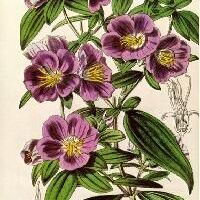Herbs or small shrubs. Leaves 3–5-veined; petiole generally short. Inflorescences generally terminal, usually clustered, rarely an elongated cyme or flowers solitary, with small to large and ovate subfoliaceous bracts and bracteoles. Flowers 4-or 5-merous. Hypanthium campanulate, usually moderately to densely covered with emergences or hairs or both. Calyx lobes distinct, triangular to ovate, often caducous, alternating with pectinate appendages (intersepalar emergences). Petals broadly obovate or orbicular, red, blue or white. Stamens 8 or 10, isomorphic, rarely anisomorphic; anthers linear, sometimes distinctly rostrate, with a terminal pore; connective not or little prolonged, with short ventral appendages in the form of a collar. Ovary 4-or 5-locular, the summit usually pubescent; ovules numerous on axile placentas; style curved. Fruit capsular, dry, loculicidal. Seeds numerous, small, cochleate and tuberculate.
Herbs, subshrubs or shrubs, usually erect, hispid, strigose or scabrid. Leaves 3–7-nerved, entire or serrulate. Inflorescence capitate, racemose or panicled. Flowers 4–5-merous. Calyx ovoid, urceolate or subglobose, usually produced beyond the ovary, rarely glabrous, usually hispid, bristly or with scales bearing pectinate or stellately arranged bristles, sometimes with such appendages alternating with the calyx-lobes. Petals obovate, rose or purple. Stamens equal; anthers linear-subulate, incurved or sigmoid; connective not or only shortly produced below the anther, without appendages or with 2 anterior tubercles. Ovary adherent to the calyx, usually by 8–10 septa, 4–5-locular, with a crown of bristles at the apex. Capsule enclosed in the dry calyx-tube. Seeds minute, cochleate.
Stamens 10, equal; anthers linear-subulate, rostrate, opening by a terminal introrse pore; connective not or slightly produced, with the appendages not anteriorly bitubercled.
Receptacle ovoid, urceolate or subglobose, usually covered by simple bristles or stellate-setose or penicillate appendages.
Ovary 4–5-locular, adhering to the receptacle by 8–10 longitudinal septa, with a crown of bristles at the apex.
Perennial erect or ascending herbs or shrubs, setose, with the branches usually 4-gonous.
Flowers 4–5-merous, solitary, capitate or paniculate.
Leaves opposite, 3–7-nerved, entire or serrulate.
Capsule 4–5-valved, included in the receptacle.
Petals obovate, ciliate at the margin.
Seeds numerous, minute, cochleate.
Sepals caducous or persistent.
Bracts caducous.

